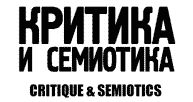ON THE SPECIFIC FEATURES OF MODERN POPULAR CULTURE: SOME THOUGHTS ON THE KNOWN THINGS
The article describes the typical features of modern popular culture: the dominance of the hyper-real object, simulation, replication, visual representation. Some of the most common critical judgments about the nature and functions of popular culture are analyzed. It is shown that production of simulacra and of hyper-real objects can be connected with the ways of production of popular forms of social and cultural existence rather than with the implementation of escapist attitudes and replacing of reality with its counterfeits. Therefore, it should be assumed that hyper-real objects do not deny the reality as such, but only its forms that have lost their efficiency, cultural significance and value in the eyes of the community or its individual groups. It is shown that the foundation and the source of the typical features of popular culture should be connected with the demand and wish for visual ization. It is argued that it is not due to the primitiveness of the consumer or an escape to the world of illusions, but to the need for the desired fullness of feeling and suitable models of understanding the world, as well as schemes for organizing and managing one’s actions. In these terms, replication should be interpreted as a way of establishing and maintaining stability, balance, completeness of theclaimed cultural and social space.
Keywords: popular culture, mass culture, simulacrum, hyper-reality, replication, visual representation
References:
Adorno, Horkheimer 1997 – AdornoТ., HorkheimerМ. The Dialectic of Enlightenment. Translation into Russian. Moscow, 1997.
Anderson 2001 – Anderson B. Imagined Communities: Reflections on the Origin and Spread of Nationalism. Translation into Russian. Moscow, 2001.
Baudrillard 1993 – Baudrillard live. Selected interviews. Ed. by M. Gane. Routledge, 1993.
Baudrillard 2000 а – Baudrillard J. In the Shadow of the Silent Majorities. Translation into Russian. Ekaterinburg, 2000.
Baudrillard 2000 b – Baudrillard J. Seduction. Translation into Russian. Moscow, 2000.
Bauman 2000 – Bauman Z. Liquid Modernity. Polity Press, 2000.
Benjamin 1996 – Benjamin W. The Work of Art in the Age of Mechanical Reproduction. Translation into Russian. Moscow, 1996.
Denzin 1995 – Denzin N. K. Tne Cinematic Society: the Voyeure’s Gaze. SAGE Publicitions, 1995.
Dubin 2005 – Dubin B.V. Another history: culture as a system of reproduction. Domestic proceeding. 2005. 4 (25). URL: http://www.strana-oz.ru/?numid=25&article=1093.">http://www.strana-oz.ru/?numid=25&article=1093">http://www.strana-oz.ru/?numid=25&article=1093. In Russian.
Lash, Urry 1994 – Lash S., Urry J. Economies of Sighs & Space. SAGE Publicution ltd., 1994.
McLuhan 2005 – McLuhanМ. The Gutenberg Galaxy: The Making of Typographic Man. Translation into Russian. Moscow, 2005.
Muzykant 1998 – Muzykant V. L. Theory and practice of modern advertising. Part 1. Moscow, 1998. In Russian.
Žižek 1998 – Žižek S. Cyberspace, or The Unbearable Reticence of Being. Translation into Russian.Art of Cinema. 1998. 1 & 2. URL: http://www.old.kinoart.ru/1998/2/19.html.">http://www.old.kinoart.ru/1998/2/19.html">http://www.old.kinoart.ru/1998/2/19.html.
Zvereva 2003 а – Zvereva V. V. Representation and Reality. Domestic proceeding. 2003. 4. URL: http://www.strana-oz.ru/?numid=13&article=612.">http://www.strana-oz.ru/?numid=13&article=612">http://www.strana-oz.ru/?numid=13&article=612. In Russian.
Zvereva 2003 b – Zvereva V. V. Television serials: made in Russia. Critical Mass. 2003. 3. URL: http://magazines.russ.ru/km/2003/3/.">http://magazines.russ.ru/km/2003/3/">http://magazines.russ.ru/km/2003/3/. In Russian.
Zvereva 2005 – Zvereva V. V. Stories told for all (a common man in the talk show). Art of Cinema. 2005. 10. URL: http://kinoart.ru/archive/2005/10/n10-article15.">http://kinoart.ru/archive/2005/10/n10-article15">http://kinoart.ru/archive/2005/10/n10-article15. In Russian.
Issue: 3, 2015
Series of issue: Issue 5
Rubric: ARTICLES
Pages: 97 — 116
Downloads: 997










